OSHA’s #7 Most Cited Standard: Scaffolding (29 CFR 1926.451)
Scaffolding violations are a persistent issue in construction. Learn key prevention strategies to ensure compliance and improve safety on your job...
EHS Insight offers an all-in-one safety management software solution tailored for organizations aiming to enhance their environmental, health and safety (EHS) programs. Our platform enables efficient management of incidents, audits, inspections, compliance, work observations, hazard and risk, training, corrective and preventative actions, sustainability initiatives, and more.
EHS Insight offers a comprehensive platform to streamline EHS oversight, from incident management to compliance. Trusted by thousands, our customizable solution enhances safety, compliance, and risk reduction, adapting to your needs as you grow. More than software—it’s your partner in success.
Quickly log and manage workplace incidents, injuries, and illnesses to comply with regulatory standards such as OSHA, WCB, RIDDOR, and MSHA and drive corrective action.
Stay audit-ready with tools for inspections, checklists, and automated compliance reporting.
Create custom checklists, schedule recurring audits, and track corrective actions in one place.
Ensure employees stay compliant with built-in LMS integrations and training record tracking.
Identify and mitigate hazards using configurable risk matrix tools.
Manage safety policies, procedures, and SOPs with version control and permissions.
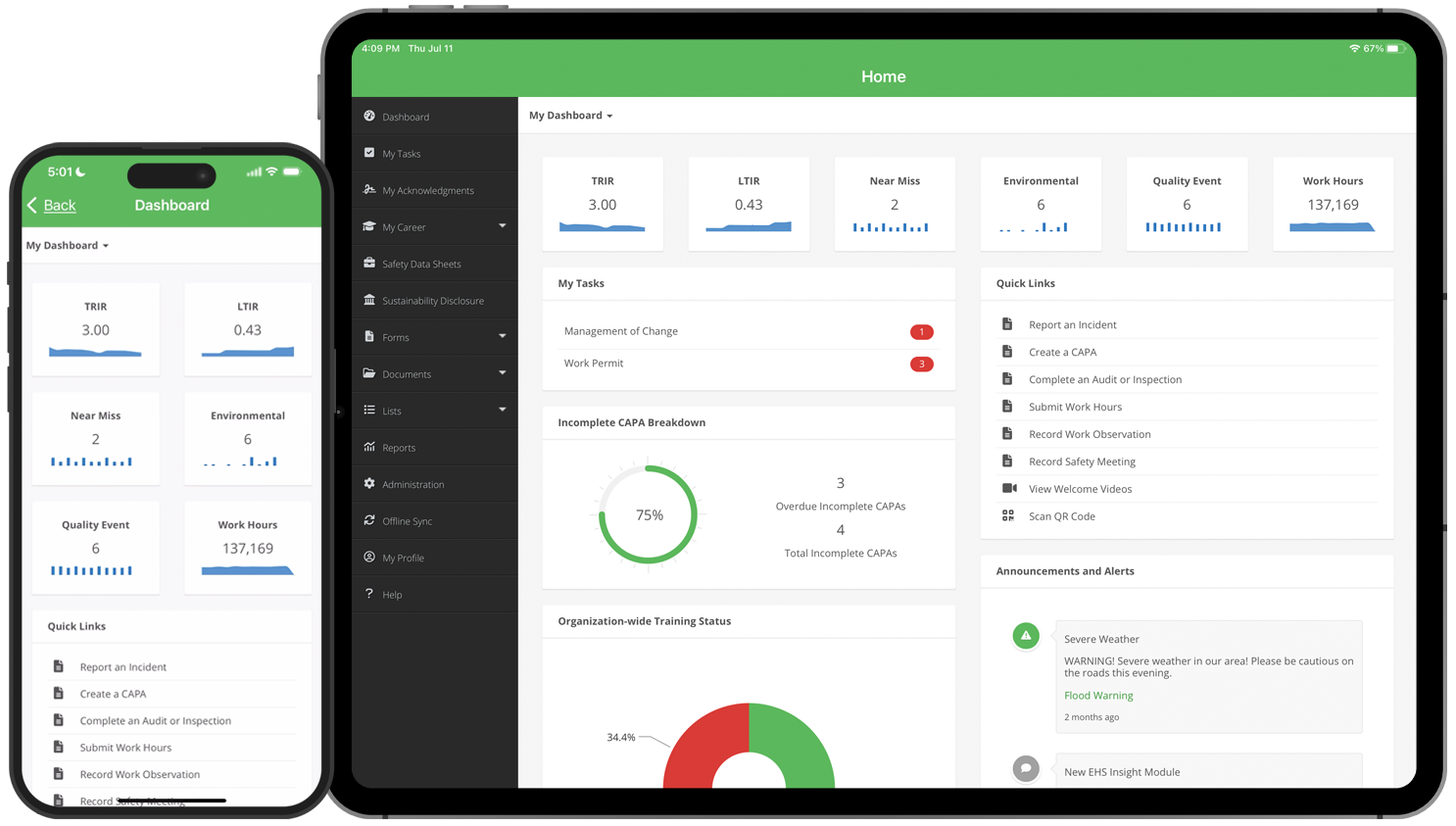

EHS Insight's safety management software is adaptable to various industries, providing tailored solutions to meet specific needs:
Manufacturing
Implement the best safety management software for manufacturing to enhance operational efficiency and worker safety.
Construction
Utilize EHS compliance tools for the construction industry to manage site-specific risks and regulatory requirements.
Oil & Energy
Address complex safety challenges with specialized features designed for the oil and energy sector.
Chemical
Ensure safe handling and compliance in chemical manufacturing and processing environments.
Mining & Metals
Manage unique hazards and compliance standards inherent in mining and metal industries.
EHS Insight delivers one of the most user-friendly experiences in EHS software today. Our intuitive user interface (UI) and seamless user experience (UX) are purpose-built to help safety professionals navigate incident tracking, compliance tasks, and risk assessments with ease. Whether you're on desktop or mobile, the platform is designed to be efficient, responsive, and easy to use—so you can focus on improving your occupational health and safety program, not struggling with software.

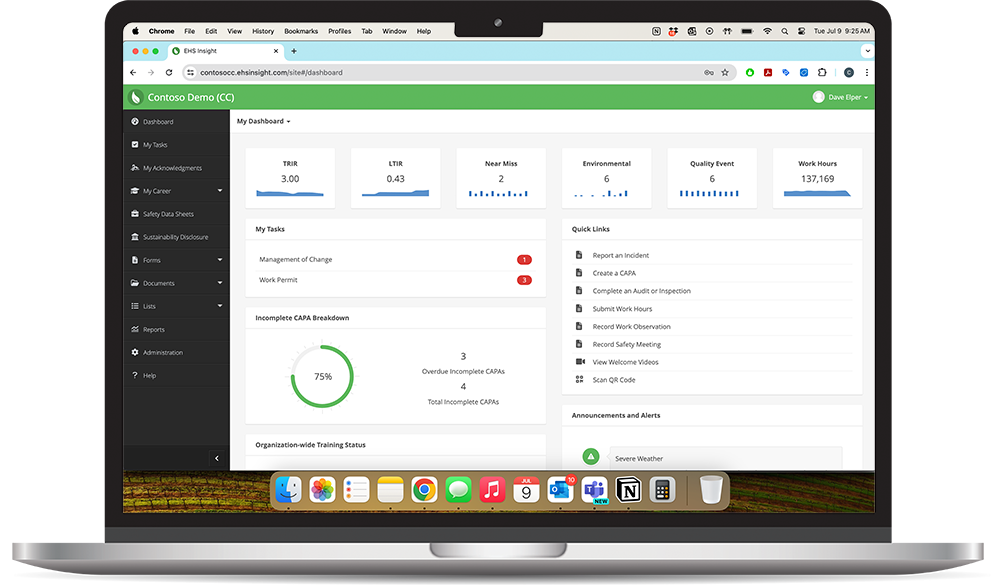
Navigating the EHS Insight platform is a breeze, thanks to our intuitive design. Whether you're a seasoned professional or new to EHS management, our clean and straightforward layout helps you find the tools and information you need quickly. We employ consistent design patterns and logical workflows that reduce the learning curve, allowing users to focus on what matters most—safety, compliance, and efficiency.

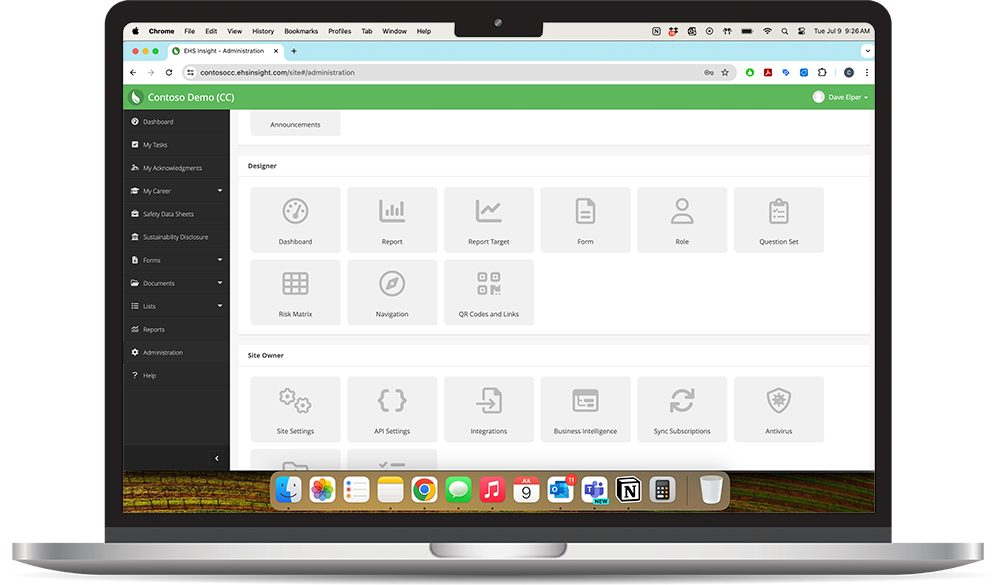
We understand that no two organizations are the same, which is why our platform offers unparalleled customizability. Users can tailor dashboards, reports, and notifications to meet their specific needs and preferences. This flexibility ensures that each user has a personalized experience, enhancing productivity and engagement.

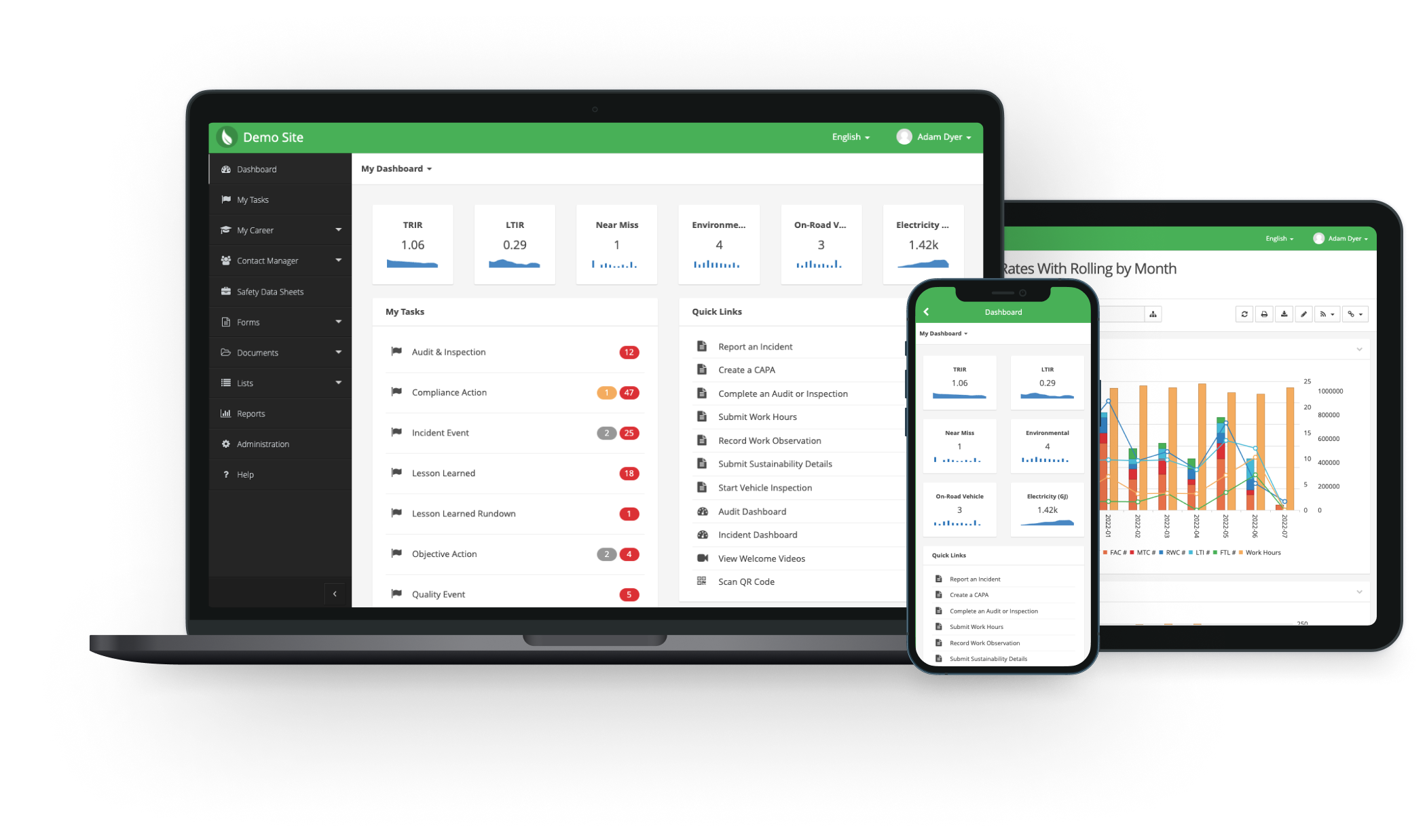
Our commitment to responsive design ensures that EHS Insight looks and performs beautifully on any device, whether it's a desktop, tablet, or smartphone. We prioritize accessibility, ensuring that our platform meets high standards for usability by all users, including those with disabilities. This dedication to inclusivity ensures that everyone can benefit from our comprehensive EHS management solutions.

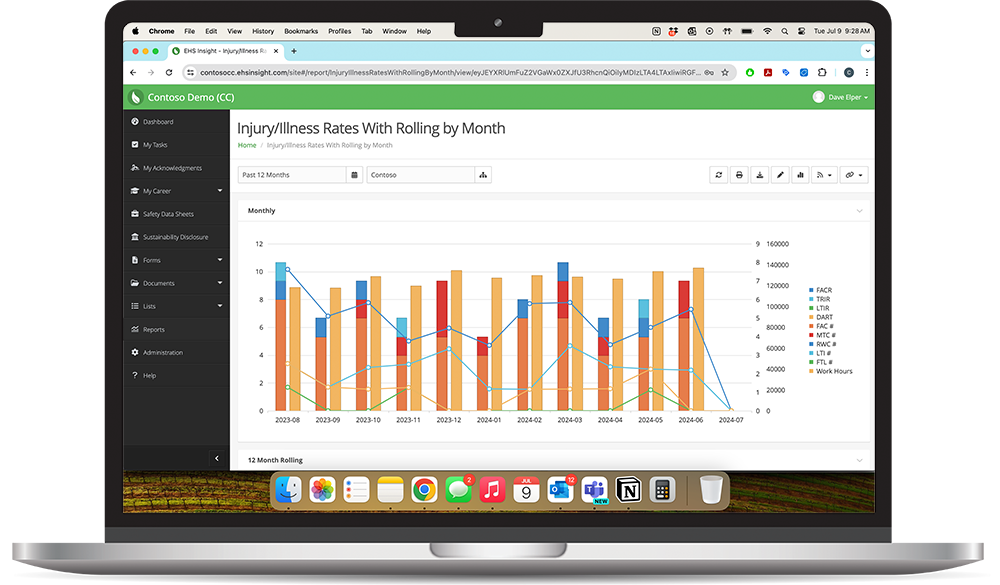
The EHS Insight platform is not only functional but also engaging. Interactive dashboards, visual analytics, and real-time data updates keep users informed and involved. By presenting information in a visually appealing and easily digestible format, we make it easier for users to stay on top of their EHS responsibilities and make informed decisions.


We are committed to continuous improvement based on user feedback. Our development team regularly updates the platform, incorporating user suggestions and the latest advancements in technology. This iterative approach ensures that our UI/UX remains cutting-edge, user-friendly, and aligned with the evolving needs of our clients.

Navigating the EHS Insight platform is a breeze, thanks to our intuitive design. Whether you're a seasoned professional or new to EHS management, our clean and straightforward layout helps you find the tools and information you need quickly. We employ consistent design patterns and logical workflows that reduce the learning curve, allowing users to focus on what matters most—safety, compliance, and efficiency.

We understand that no two organizations are the same, which is why our platform offers unparalleled customizability. Users can tailor dashboards, reports, and notifications to meet their specific needs and preferences. This flexibility ensures that each user has a personalized experience, enhancing productivity and engagement.

Our commitment to responsive design ensures that EHS Insight looks and performs beautifully on any device, whether it's a desktop, tablet, or smartphone. We prioritize accessibility, ensuring that our platform meets high standards for usability by all users, including those with disabilities. This dedication to inclusivity ensures that everyone can benefit from our comprehensive EHS management solutions.

The EHS Insight platform is not only functional but also engaging. Interactive dashboards, visual analytics, and real-time data updates keep users informed and involved. By presenting information in a visually appealing and easily digestible format, we make it easier for users to stay on top of their EHS responsibilities and make informed decisions.

We are committed to continuous improvement based on user feedback. Our development team regularly updates the platform, incorporating user suggestions and the latest advancements in technology. This iterative approach ensures that our UI/UX remains cutting-edge, user-friendly, and aligned with the evolving needs of our clients.
Sean Cooley, Safety Manager at Masters Gallery Foods, shares how EHS Insight has transformed their safety processes and strengthened their commitment to workplace safety.
"My favorite thing about EHS Insight is the dashboard, and having the ability to generate reports to understand better how our processes are performing. I also like the quality and responsiveness of the support team. They can resolve issues and answer questions about the system quickly."
"One of the key reasons we chose EHS Insight is because it is out-of-the-box with the ability to put internal customization points in it."
“EHS allows the freedom to make changes. If we need to make an audit or change a report, the others charge for it on top of the subscription. We want to have an annual fee and want to be able to budget for that annual fee not an annual fee PLUS.”
Safety software is a specialized tool designed to help organizations manage and enhance workplace safety. It provides a centralized platform for tracking and managing safety-related data, incidents, audits, and compliance with regulatory standards. By using safety software, organizations can streamline safety processes, improve incident response times, and proactively identify and mitigate safety risks. It promotes a culture of safety by facilitating employee engagement, training, and adherence to safety protocols, ultimately reducing accidents and promoting a safer work environment.
When selecting safety software, organizations should prioritize features that support comprehensive safety management. This includes robust incident management capabilities for reporting, investigating, and tracking incidents, as well as tools for conducting safety audits and ensuring compliance with regulatory standards. Effective safety software should also offer analytics functionalities to analyze safety data, identify trends, and predict potential risks. It should support training initiatives by providing accessible modules and tracking employee certifications. Mobile accessibility is another essential feature, allowing users to report incidents and conduct audits seamlessly from the field.
Safety software plays a pivotal role in driving continuous improvement in safety performance across organizations. It enables proactive risk management through real-time monitoring and analysis of safety metrics, empowering proactive decision-making and intervention. By streamlining incident reporting and investigation processes, safety software facilitates quicker response times and more effective corrective actions. Moreover, it ensures compliance with safety regulations and standards, reducing the organization's exposure to penalties and liabilities. Through training and awareness initiatives, safety software promotes a culture of safety among employees, enhancing adherence to safety protocols and ultimately fostering a safer and more productive work environment.
Safety management system software is a digital platform designed to help businesses manage and improve their safety and health programs. It centralizes safety data, including data sheets, incident reports, and safety programs, making it easier to monitor performance, implement corrective actions, and ensure compliance with health and safety regulations.
Implementing workplace safety software brings numerous benefits, including improved employee engagement in safety culture, enhanced safety performance through real-time data, and the ability to mitigate risks more effectively. It streamlines reporting processes, allows for the creation of custom reports, and helps identify gaps in safety practices. Additionally, it supports environmental health and safety (EHS) management, contributing to the overall well-being of your entire organization.
Yes, modern safety management software is designed to be accessible on mobile devices. This feature allows employees involved in safety tasks to file reports, access training materials, and assign tasks directly from their mobile devices, improving efficiency and ensuring immediate action in threatening situations.
Key features include incident reporting, safety audits, environmental management, the ability to schedule safety meetings and training sessions, and much more. These features are crucial for maintaining a comprehensive online health and safety management system that keeps employees informed, engaged, and safe.
Safety management software helps organizations set and achieve safety goals by providing tools for analyzing trends, improving quality control, and reducing workplace incidents. It facilitates a streamlined approach to managing safety protocols and ensuring that safety programs are up-to-date and effective. By leveraging the capabilities of health and safety management systems, companies can significantly reduce incidents and foster a strong safety culture within their workforce.
Scaffolding violations are a persistent issue in construction. Learn key prevention strategies to ensure compliance and improve safety on your job...
Review the 2025 highlights of EHS Insight, including major platform upgrades, AI advancements, strategic partnerships, and the roadmap for a safer,...
Ensure a safe and festive workplace this holiday season with essential fire safety tips and preventive measures to mitigate common holiday fire...